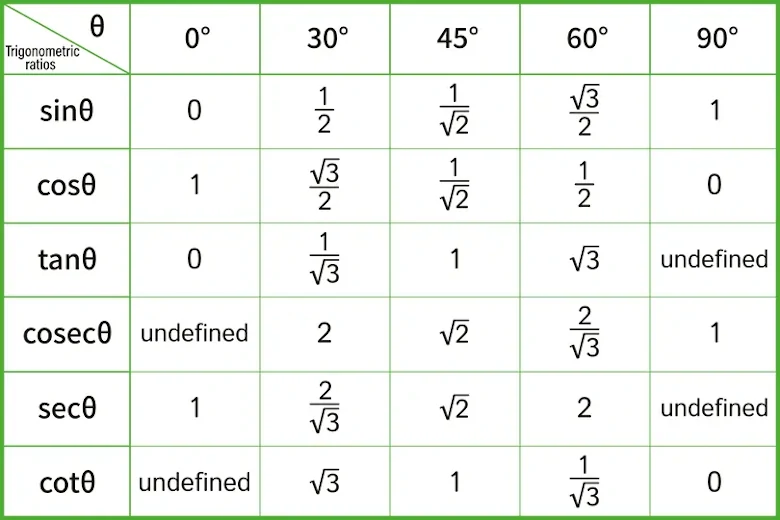Understanding Trigonometric Ratios for Special Angles: 0°, 30°, 45°, 60°, 90°

Trigonometry, a branch of mathematics, deals with the relationships between the angles and sides of triangles. Trigonometric ratios are fundamental tools in trigonometry, and understanding them is crucial for solving various mathematical and real-world problems.
In this article, we will explore the trigonometric ratios for special angles: \(0^\circ\), \(30^\circ\), \(45^\circ\), \(60^\circ\) and \(90^\circ\) as well as introduce \(\text{Cosec}\), \(\text{Sec}\) and \(\text{Cot ratios}\).
Watch our video lesson!
Note: This video lesson on Trigonometic Functions is just one of the many weekly GenieClass lessons you can attend from the comfort of your home. If you prefer learning in a physical classroom, check out our new tech-enhanced tuition classes at Geniebook CAMPUS.
What Are Trigonometric Ratios?
Trigonometric ratios are mathematical functions that relate the angles of a right triangle to the ratios of its sides. There are six primary trigonometric ratios: \(\text{sine (sin)}\), \(\text{cosine (cos)}\), \(\text{tangent (tan)}\), \(\text{cosecant (csc)}\), \(\text{secant (sec)}\) and \(\text{cotangent (cot)}\). These ratios are defined as follows:
|
The ratio of the length of the side opposite the angle to the hypotenuse. |
|---|---|
|
The ratio of the length of the adjacent side to the hypotenuse. |
|
The ratio of the length of the side opposite the angle to the length of the adjacent side. |
|
The reciprocal of \(\displaystyle\mathrm{sine, \;csc = \frac{1}{sin}}\). |
|
The reciprocal of \(\displaystyle{\mathrm{cosine,\; sec = \frac{1}{cos}}}\). |
|
The reciprocal of \(\displaystyle{\mathrm{tangent,\; cot = \frac{1}{tan}}}\). |
Why Are Special Angles Important?
Special angles, such as \(0^\circ\), \(30^\circ\), \(45^\circ\), \(60^\circ\) and \(90^\circ\) are commonly encountered in trigonometry and real-world scenarios. They simplify calculations and provide valuable insights into various problems.
Trigonometric Ratios for \(\text{Cosec}\), \(\text{Sec}\) and \(\text{Cot}\) for Special Angles
For special angles, the \(\text{cosecant (csc)}\), \(\text{secant (sec)}\) and \(\text{cotangent (cot)}\) ratios can be calculated by taking the reciprocals of their corresponding \(\text{sine (sin)}\), \(\text{cosine (cos)}\) and \(\text{tangent (tan)}\) ratios.
Let's delve into the trigonometric ratios for these angles:
Trigonometric Ratios for \(0^\circ\)
- \(\mathrm{Sine \;(\sin 0^{\circ}) = 0}\)
- \(\mathrm{Cosine \;(\cos 0^{\circ}) = 1}\)
- \(\mathrm{Tangent \;(\tan 0^{\circ}) = 0}\)
- \(\mathrm{Cosecant \;(\csc 0^{\circ}) = Undefined}\)
- \(\mathrm{Secant \;(\sec 0^{\circ}) = 1}\)
- \(\mathrm{Cotangent \;(\cot 0^{\circ}) = Undefined}\)
For \(0^\circ\), the \(\text{sine}\) is \(0\), the \(\text{cosine}\) is \(1\), the \(\text{tangent}\) is \(0\), and the \(\text{cosecant}\) and \(\text{cotangent}\) are \(\text{undefined}\) because the \(\text{triangle's opposite}\) and \(\text{adjacent sides}\) have \(\text{zero length}\).
Trigonometric Ratios for \(30^\circ\)
- \(\displaystyle\mathrm{Sine \;(\sin 30^{\circ}) = \frac{1}{2}}\)
- \(\displaystyle\mathrm{Cosine \;(\cos 30^{\circ}) = \frac{\sqrt{3}}{2}}\)
- \(\displaystyle\mathrm{Tangent \;(\tan 30^{\circ}) = \frac{1}{\sqrt{3}}}\)
- \(\displaystyle\mathrm{Cosecant \;(\csc 30^{\circ}) = 2}\)
- \(\displaystyle\mathrm{Secant \;(\sec 30^{\circ}) = \frac{2}{\sqrt{3}}}\)
- \(\displaystyle\mathrm{Cotangent \;(\cot 30^{\circ}) = \sqrt{3}}\)
Trigonometric Ratios for \(45^\circ\)
- \(\displaystyle\mathrm{Sine \;(\sin 45^{\circ}) = \frac{1}{\sqrt{2}}}\)
- \(\displaystyle\mathrm{Cosine \;(\cos 45^{\circ}) = \frac{1}{\sqrt{2}}}\)
- \(\displaystyle\mathrm{Tangent \;(\tan 45^{\circ}) = 1}\)
- \(\displaystyle\mathrm{Cosecant \;(\csc 45^{\circ}) = \sqrt{2}}\)
- \(\displaystyle\mathrm{Secant \;(\sec 45^{\circ}) = \sqrt{2}}\)
- \(\displaystyle\mathrm{Cotangent \;(\cot 45^{\circ}) = 1}\)
Trigonometric Ratios for \(60^\circ\)
- \(\displaystyle\mathrm{Sine \;(\sin 60^{\circ}) = \frac{\sqrt{3}}{2}}\)
- \(\displaystyle\mathrm{Cosine \;(\cos 60^{\circ}) = \frac{1}{2}}\)
- \(\displaystyle\mathrm{Tangent \;(\tan 60^{\circ}) = \sqrt{3}}\)
- \(\displaystyle\mathrm{Cosecant \;(\csc 60^{\circ}) = \frac{2}{\sqrt{3}}}\)
- \(\displaystyle\mathrm{Secant \;(\sec 60^{\circ}) =2}\)
- \(\displaystyle\mathrm{Cotangent \;(\cot 60^{\circ}) = \frac{1}{\sqrt{3}}}\)
Trigonometric Ratios for \(90^\circ\)
- \(\mathrm{Sine \;(\sin 90^{\circ}) = 1}\)
- \(\mathrm{Cosine \;(\cos 90^{\circ}) = 0}\)
- \(\mathrm{Tangent \;(\tan 90^{\circ}) = Undefined}\)
- \(\mathrm{Cosecant \;(\csc 90^{\circ}) = 1}\)
- \(\mathrm{Secant \;(\sec 90^{\circ}) = Undefined}\)
- \(\mathrm{Cotangent \;(\cot 90^{\circ}) = 0}\)
In a \(90^\circ\) angle, the \(\text{sine}\) is \(1\), the \(\text{cosine}\) is \(0\), the \(\text{tangent}\) is \(\text{undefined}\), the \(\text{undefined}\) is \(1\), the \(\text{secant}\) is \(\text{undefined}\) and the \(\text{cotangent}\) is \(0\) because the \(\text{adjacent sides}\) has \(\text{zero length}\).
Practical Applications
Understanding these trigonometric ratios, including \(\text{cosecant}\), \(\text{secant}\) and \(\text{cotangent}\) is essential in various fields, including engineering, physics, and computer graphics. They are used in solving problems related to angles, distances, and forces.
Tips For Remembering Ratios
To remember these ratios easily, you can use the acronym "\(\text{SOHCAHTOA}\)":
- \(\small\text{SOH: Sine (sin)}\) is \(\small\text{Opposite/Hypotenuse}\).
- \(\small\text{CAH: Cosine (cos)}\) is \(\small\text{Adjacent/Hypotenuse}\).
- \(\small\text{TOA: Tangent (tan)}\) is \(\small\text{Opposite/Adjacent}\).
- \(\small\text{CSOH: Cosecant (csc)}\) is \(\small\text{Hypotenuse/Opposite}\).
- \(\small\text{CAH: Secant (sec)}\) is \(\small\text{Hypotenuse/Adjacent}\).
- \(\small\text{TOAC: Cotangent (cot)}\) is \(\small\text{Adjacent/Opposite}\).
Common Mistakes To Avoid
Common mistakes include mixing up the ratios, forgetting the definitions, or using the wrong formula. Practice and understanding the concepts will help avoid these errors.
Practice Problems
Here are some practice problems to reinforce your knowledge:
- Find \(\mathrm{csc \,45^{\circ}}\).
- Calculate \(\mathrm{sec \,30^{\circ}}\).
- Determine \(\mathrm{cot \,60^{\circ}}\).
Conclusion
Trigonometric ratios, including sine, cosine, tangent, cosecant, secant, and cotangent, for special angles are essential tools for solving mathematical and real-world problems. Understanding these ratios simplifies calculations and opens up a world of applications in various fields. Remember the acronym \(\text{SOHCAHTOA}\) to keep the ratios straight, and practice to master them.


 SG
SG  VN
VN 


















